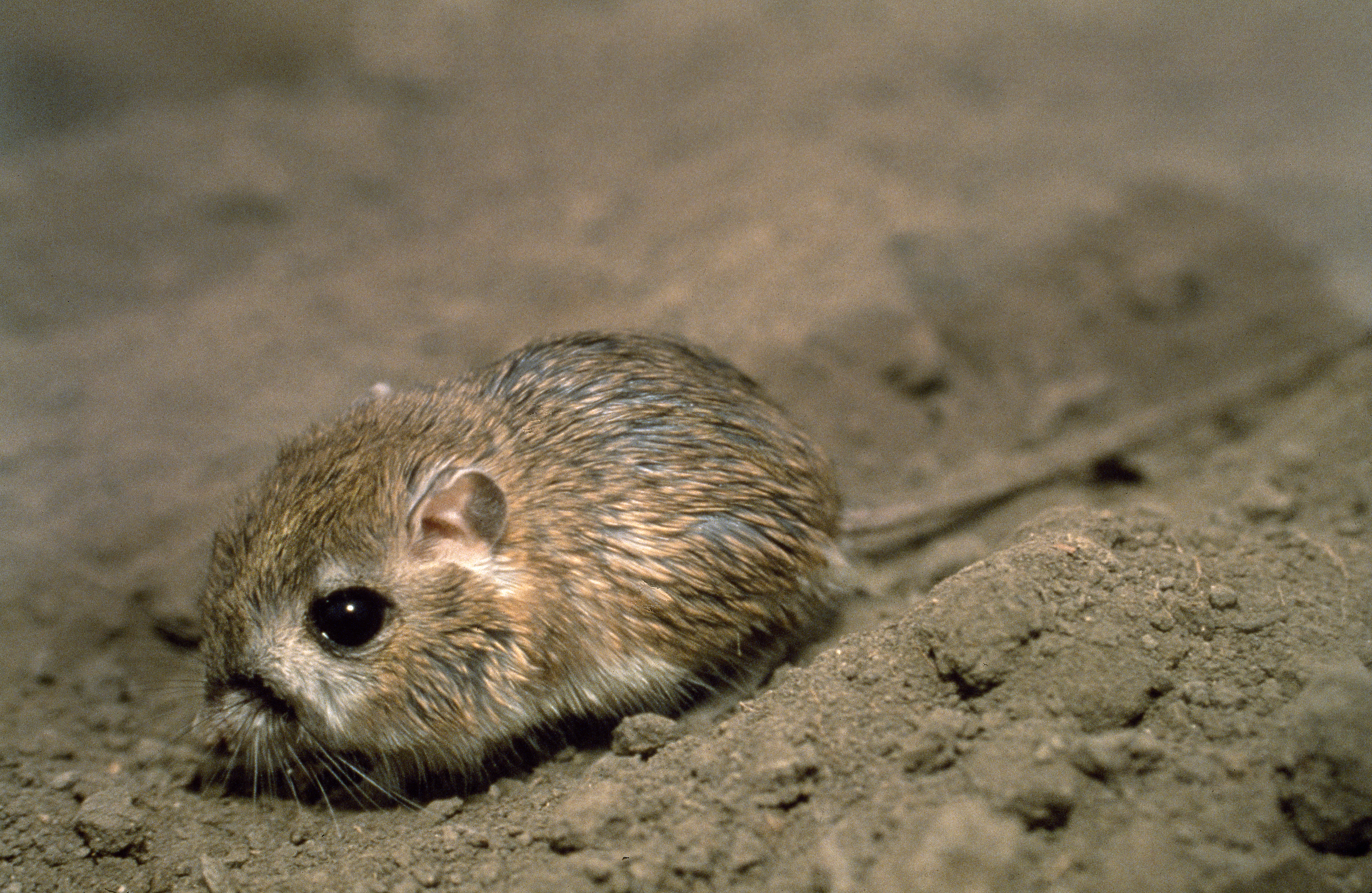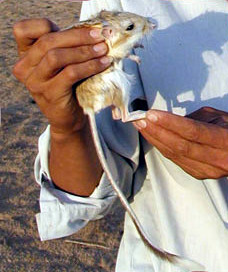|
Dipodomys
Kangaroo rats, small mostly nocturnal rodents of genus ''Dipodomys'', are native to arid areas of western North America. The common name derives from their bipedal form. They hop in a manner similar to the much larger kangaroo, but developed this mode of locomotion independently, like several other clades of rodents (e.g., dipodids and hopping mice). Description Kangaroo rats are four or five-toed heteromyid rodents with big hind legs, small front legs, and relatively large heads. Adults typically weigh between Nader, I.A. 1978"Kangaroo rats: Intraspecific Variation in ''Dipodomus spectabilis'' Merriami and ''Dipodomys deserti'' Stephens" ''Illinois biological monographs''; 49: 1-116. Chicago, University of Illinois Press. The tail of a kangaroo rat is longer than its body and head combined. Another notable feature of kangaroo rats is their fur-lined cheek pouches, which are used for storing food. The coloration of kangaroo rats varies from cinnamon buff to dark gray, depend ... [...More Info...] [...Related Items...] OR: [Wikipedia] [Google] [Baidu] |
Dipodomys Merriami
Merriam's kangaroo rat (''Dipodomys merriami'') is a species of rodent in the family Heteromyidae. The species name commemorates Clinton Hart Merriam. It is found in the Upper and Lower Sonoran life zones of the southwestern United States, Baja California, and northern Mexico. Description Merriam's kangaroo rats, like other kangaroo rats and pocket mice, are members of the family Heteromyidae. Each species within this family has fur-lined food storage pouches. The cheek pouch is utilized as a portable cache for food while foraging. Kangaroo rats are named for their extremely long, kangaroo-like hind feet and they are almost completely bipedal. They hop or jump rather than scurry or run. Because of this, most heteromyid rodents also have a relatively long tail that acts to counterbalance the hopping/jumping form of locomotion. Fur color varies between populations within the species' range, but the back color is generally light brown or tan. The ''merriami'' species is smaller than ... [...More Info...] [...Related Items...] OR: [Wikipedia] [Google] [Baidu] |
Dipodomys Heermanni
Heermann's kangaroo rat (''Dipodomys heermanni'') is a species of kangaroo rat, a rodent in the family Heteromyidae. Their long smooth pelage resembles typical kangaroo rats, with their dorsal side showing a mixed range of olive, black and orange colors. Nine different sub-species of ''Dipodomys heermanni' had been proposed: * ''Dipodomys heermanni arenae'' * ''Dipodomys heermanni berkeleyensis'' (Berkeley kangaroo rat) * ''Dipodomys heermanni dixoni'' (Merced kangaroo rat) * ''Dipodomys heermanni goldmani'' * ''Dipodomys heermanni heermanni'' (Heermann's kangaroo rat) * ''Dipodomys heermanni jolonensis'' * '' Dipodomys heermanni morroensis'', (Morro Bay kangaroo rat) * ''Dipodomys heermanni swarthi'' * ''Dipodomys heermanni tularensis'' However, recent mitochondrial DNA and morphometric analyses failed to show support for any genetic differentiation or morphological clustering across geography to support the above subspecies delineations. The dental formula of ''Dipodomys heerma ... [...More Info...] [...Related Items...] OR: [Wikipedia] [Google] [Baidu] |
Heteromyidae
Heteromyidae is a family of rodents consisting of kangaroo rats, kangaroo mice, pocket mice and spiny pocket mice. Most heteromyids live in complex burrows within the deserts and grasslands of western North America, though species within the genus '' Heteromys'' are also found in forests and their range extends as far south as northern South America. They feed mostly on seeds and other plant parts, which they carry in their fur-lined cheek pouches to their burrows. Although they are very different in physical appearance, the closest relatives of the heteromyids are pocket gophers in the family Geomyidae. Description There are about fifty-nine members of the family Heteromyidae divided among six genera. They are all small rodents, the largest being the giant kangaroo rat (''Dipodomys ingens'') with a body length of and a tail a little longer than this. In many species the tail is tufted and is mainly used for balance. Other adaptations include partially fused vertebrae in t ... [...More Info...] [...Related Items...] OR: [Wikipedia] [Google] [Baidu] |
Dipodomys Ordii
Ord's kangaroo rat (''Dipodomys ordii'') is a kangaroo rat native to western North America, specifically the Great Plains and the Great Basin, with its range extending from extreme southern Canada to central Mexico. Ord's kangaroo rat has a fifth toe on its hip feet, which distinguishes it from '' Dipodomys elator''. It is bicolored with gold-brown dorsal hair and a white stomach. It has a long tail with a bushy tip, and is dark dorsally and ventrally with a white lateral stripe. Its hind feet are modified for jumping, and exceed 35 mm in length, and its total length exceeds 240 mm. Its tail is usually less than 160 mm, distinguishing it from ''D. elator'' (which exceeds 160 mm). Though a common species in the United States, the population in Canada is considered endangered. Taxonomy The currently accepted scientific name for Ord's kangaroo rat is ''Dipodomys ordii'' Woodhouse. It belongs to the family Heteromyidae, kangaroo rats and mice. HallHall, E. Raymon ... [...More Info...] [...Related Items...] OR: [Wikipedia] [Google] [Baidu] |
Dipodomys Stephensi
Stephens's kangaroo rat (''Dipodomys stephensi'') is a species of rodent in the family Heteromyidae. It is endemic to the Southern California region of the United States, primarily in western Riverside County. The species is named after American zoologist Frank Stephens (1849–1937). The natural habitat of Stephens's kangaroo rat is sparsely vegetated temperate grassland. This habitat has been destroyed or modified for agriculture throughout the species' range; as a result, Stephens's kangaroo rat is listed as a threatened species by the U.S. Fish and Wildlife Service. It occurs sympatrically with the agile kangaroo rat, but tends to prefer few shrubs and gravelly soils to the agile's preference for denser shrubs.Price, Mary V., William S. Longland, and Ross L. Goldingay. 1991. "Niche Relationships of Dipodomys agilis and D. stephensi: Two Sympatric Kangaroo Rats of Similar Size." American Midland Naturalist 126 (1) (July 1): 172–186. . . Description This kangaroo rat is p ... [...More Info...] [...Related Items...] OR: [Wikipedia] [Google] [Baidu] |
Dipodomys Venustus
The narrow-faced kangaroo rat (''Dipodomys venustus'') is one of almost 20 species of kangaroo rats, a rodent in the family Heteromyidae. It is endemic to California in the United States. Like all other heteromyids, the dental formula of ''Dipodomys venustus'' is . Narrow-faced kangaroo rats lives within chaparral, mixed chaparral, and on sandy soils with oak or pine. They are distributed along West-central California in the coastal mountains.Best, Troy L. “Dipodomys Venustus.” ''Mammalian Species'', no. 403, 1992, pp. 1–4. ''JSTOR'', JSTOR, www.jstor.org/stable/3504315.Retrieved 3 December 2017. They have been divided into three subspecies: * ''Dipodomys venustus venustus'' ( Santa Cruz kangaroo rat), which inhabit the Santa Cruz Mountains and Mount Hamilton range, the latter a central sub-range of the Diablo Range * '' Dipodomys venustus elephantinus'' ( Elephant-eared or big-eared kangaroo rat), which inhabit the Gabilan Range and southern Diablo Range * '' Dipodomys v ... [...More Info...] [...Related Items...] OR: [Wikipedia] [Google] [Baidu] |
Dipodomys Elator
The Texas kangaroo rat (''Dipodomys elator'') is a rodent of the family Heteromyidae. It is found in Texas and Oklahoma in the United States, where it often lives in association with brush species, like mesquite and lotebush, growing in areas with firm clay-loam soils. The species is listed as threatened by the Texas Parks and Wildlife Department and the IUCN The International Union for Conservation of Nature (IUCN) is an international organization working in the field of nature conservation and sustainable use of natural resources. Founded in 1948, IUCN has become the global authority on the status ... lists the species as vulnerable. Description It is a relatively large kangaroo rat that ranges in size from approximately 60 grams to 95 or more. Males and females of this species are sexually dimorphic, males being larger than females. Its distribution is within north-central Texas and it is only found within 13 counties. Diet and behavior At one time, many thought that Te ... [...More Info...] [...Related Items...] OR: [Wikipedia] [Google] [Baidu] |
Dipodomys Ingens
The giant kangaroo rat (''Dipodomys ingens'') is an endangered species, endangered species of heteromyid rodent endemic to California. Description The giant kangaroo rat, is the largest of over 20 species of kangaroo rats, which are small members of the rodent family. It measures about in length, not including its long, tufted tail, and is tan or brown in color. Like other kangaroo rats it has a large head, large eyes, and long, strong hind legs which helps it hop quickly. The giant kangaroo rat lives on dry, sandy grasslands and digs burrows in loose soil. It lives in colonies, and the individuals communicate with each other by drumming their feet on the ground. These foot thumping signals range from single, short thumps to long, drawn out "footrolls" that can average over 100 drums at 18 drums per second. These audible signals serve both as a warning of approaching danger, as a territorial communication, and to communicate mating status. Kangaroo rats are primarily seed eate ... [...More Info...] [...Related Items...] OR: [Wikipedia] [Google] [Baidu] |
Dipodomys Deserti
The desert kangaroo rat (''Dipodomys deserti'') is a rodent species in the family Heteromyidae that is found in desert areas of southwestern North America. It is one of the large kangaroo rats, with a total length greater than and a mass greater than . Range The desert kangaroo rat is found in arid parts of southwestern North America, including Death Valley, the Great Basin, the Mojave Desert, and portions of the Sonoran Desert.Rieth, W. and Boykin, K.G. (2004-2007) Southwest Regional Gap Analysis Wildlife Habitat Relationship - Desert Kangaroo Rat. New Mexico Cooperative Fish & Wildlife Research Unit, New Mexico State University. Accessed 2009-06-2 Though kangaroo rats persist in a variety of soils, desert kangaroo rats live exclusively in areas with loose sand, often dune terrain. The places on this list constitute some of the most extreme deserts in the United States including Death Valley, which has the record for the hottest place on the continent. Habitat Desert kangaroo ... [...More Info...] [...Related Items...] OR: [Wikipedia] [Google] [Baidu] |
Dipodomys Californicus
The California kangaroo rat (''Dipodomys californicus'') is a species of rodent in the family Heteromyidae. However, populations are declining, having not fully recovered after the drought in California from 2013 to 2015 destroyed their habitat ( the grasslands) and changed it into desert. Description Size The California kangaroo rat is, on average, 312 mm long, with its tail vertebrae comprising 195mm of that total length. Based on its length, experts conclude the weight of the species to be around 75 grams, making its size fairly normal amongst other kangaroo rats in California. The species generally tends to be larger in the northern areas of its distribution (near Modoc County), whereas the smaller animals are often found further south, near the SF Bay Area and Marin County. Coloration ''Dipodomys californicus'' has an almost all-white underside, including its feet, belly, and forelegs; they also have a dash of black near the ankle. The upper surface of the body tends t ... [...More Info...] [...Related Items...] OR: [Wikipedia] [Google] [Baidu] |
Banner-tailed Kangaroo Rat
The banner-tailed kangaroo rat (''Dipodomys spectabilis'') is a species of rodent in the family Heteromyidae. It is found in arid environments in the southwestern United States and Mexico where it lives in a burrow by day and forages for seeds and plant matter by night. Description The banner-tailed kangaroo rat can grow to a length of about . The dorsal surface is ochre-buff with some black-tipped hairs and the underparts are white. The species' most distinctive characteristic is the black-banded, white-tipped bushy tail which is waved like a banner. The hind legs of the kangaroo rat are much longer than its forelegs and locomotion is by hopping. Distribution and habitat The banner-tailed kangaroo rat is found in the southwestern United States and Mexico in two isolated populations. The range of the larger northern population includes arid parts of western Texas, much of Arizona and northern New Mexico, and the Mexican states of Sonora, Chihuahua and Zacatecas. The southern po ... [...More Info...] [...Related Items...] OR: [Wikipedia] [Google] [Baidu] |


